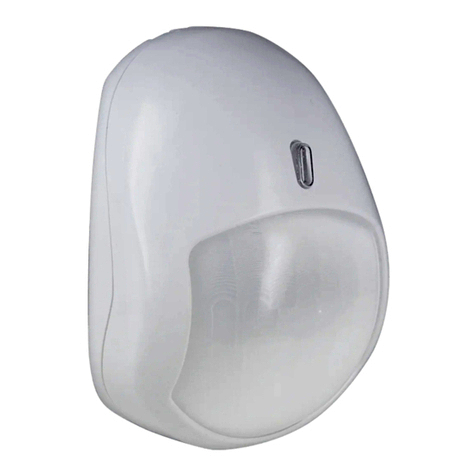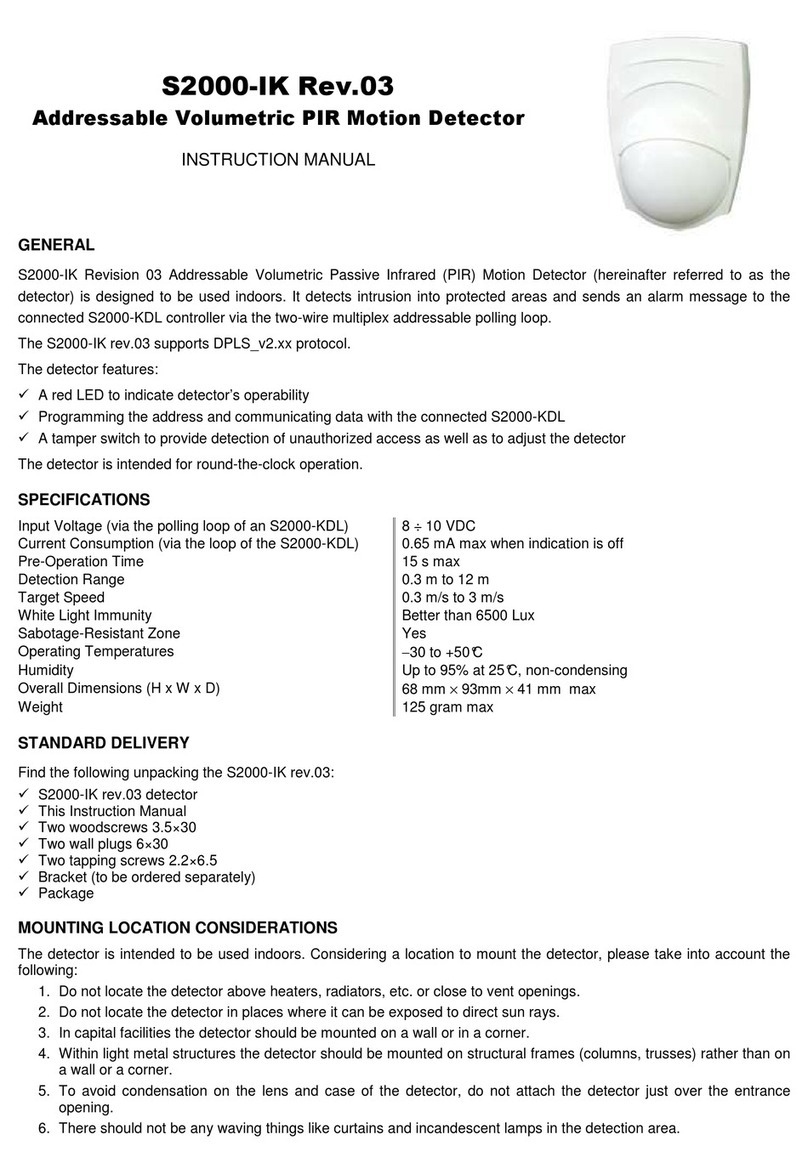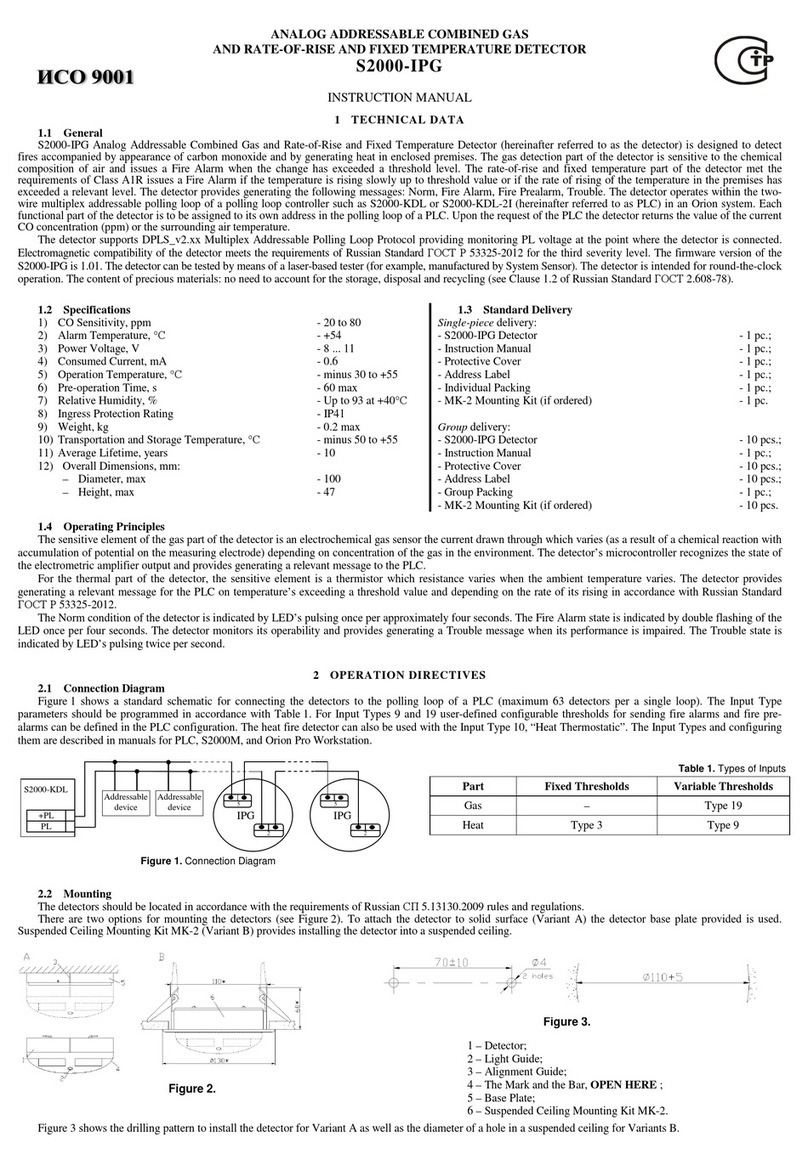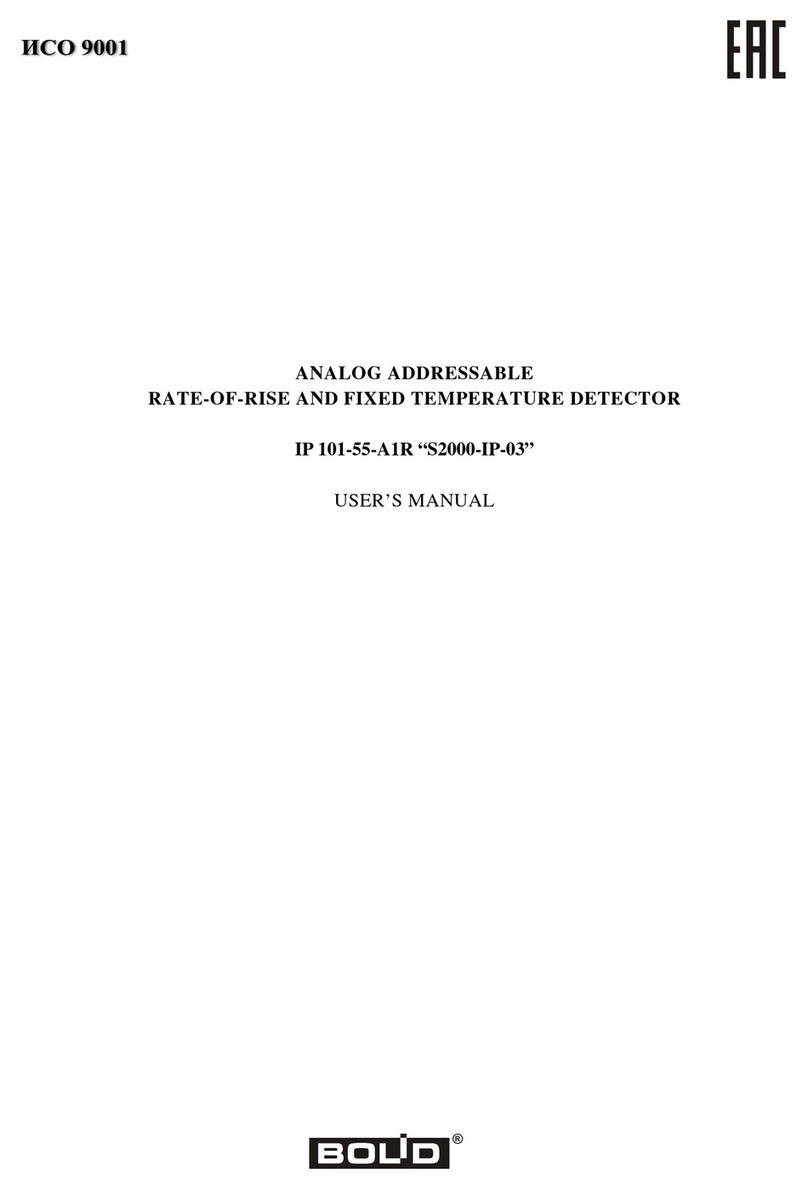
4
8MAINTENANCE AND REPAIR
8.1 At least once a year the following maintenance works shall be performed:
-Inspection for visible physical damage;
-Visual checking of dust on the surface of the insect screen. In case of any dust, remove it with a vacuum cleaner (by pumping of air).
At least once every two years check the detector operability as described in Clause 7 of this manual.
8.2 When the detector indicators flash triply every 6 s, which indicates the Contaminated Chamber conditions, clean the sensing chamber by doing the
following:
1)
Remove the detector from the base as described in Clause 5.5 of this manual.
2)
Remove the detector cover (Figure 1, Position 6) from the detector body by holding it by the stiffeners and rotating it slightly counterclockwise.
Then take out one-by-one the sensing chamber cover (Figure 1, Position 7) and the screen (Figure 1, Position 8).
3)
Clean the sensing chamber cover, the screen, and the sensing chamber itself with a soft brush.
W AR N I N G ! The sensing chamber shall be mandatory cleaned when the smoke detector enters the Contaminated Chamber conditions.
Otherwise, this can trigger false alarms.
8.3 Maintenance of the detector as a part of a fire alarm system is to be arranged in accordance with the technical guide “Maintenance of fire alarm
systems and public address and general alarm systems of type 1-2 in Orion ISS”, and maintenance of the detector as a part of a fire extinguishing
installation is to be arranged as per the technical guide “Maintenance of fixed fire suppression systems based on S2000-ASPT Fire Alarm and
Extinguishing Control Unit”.
8.4 When the light indicators of the detector issue four flashes spaced 200 ms apart every 6 s, which means the Fault condition, the detector needs to be
repaired. A defective detector is subject to repair by the manufacturer or in authorized repair centers. While submitting the product
for repair, please
always apply a report describing the possible failure to it.
W A R N I NG ! T h e m a n u f a c t u r e r d o e s n o t a c c e p t a ny c l a i m s w i t h o u t a m a l f un c t i o n r e p o r t a p pl i e d .
8.5 A product’s failure resulted from consumer’s not observing mounting or operation rules shall not be a reason for claims and warranty repair.
W A R N I N G !
Do not try to remove the printed circuit board; this will automatically void the warranty liabilities.
8.6 Claims should be submitted to the following address:
NVP BOLID, #4 Pionerskaya Str., Korolyov, Moscow Region, 141070, Russia
8.7
In case of any issue related to use of the product, please contact the technical support: +7 (495) 775-71-55 or e-mail: [email protected]. 9TRANSPORTING, STORAGE, DISPOSAL
9.1 The detectors in a transport container are to be transported by any type of covered vehicles in accordance with the requirements of actual regulatory
documents.
9.2 The detectors shall be stored in consumer packages in heated warehouse premises at temperatures +5°Сthrough +40°Сand relative humidity up to
80% at +20°С.
9.3 In a transport container the detectors can be stored in unheated warehouse premises at ambient temperatures -50°Сthrough +50°Сand relative
humidity up to 95% at +35°С.
9.4 The detector should be disposed of considering that there are no toxic components in it. The detector’s enclosure is made of recyclable ABS plastic.
9.5 The content of precious materials: does not require accountability for storage, retirement and disposal (Clause 1.2 of GOST 2.608-78).
9.6 The content of non-ferrous metals: does not require accountability for retirement and further disposal.
10 MANUFACTURER WARRANTY
The warranty period is 18 months since the day of putting the detector into operation but no more than 24 months from the manufacturer’s date of
production.
11 CERTIFICATION INFORMATOIN
11.1 DIP-31 complies with the requirements of Technical Regulations “On Fire Safety Requirements” (Federal Law No.123-FZ dated July 22, 2008,
GOST R 53325-2012) and is awarded with Conformity Certificate No. C-RU.ЧС13.В.001193.
11.2 DIP-31 complies with the requirements of Technical Regulations of Custom Union TR CU 020/2011 and is awarded with Declaration of
Conformity ЕАЭС №RU Д-RU.МЕ61.В.00019/18.
11.3 DIP-31 complies with the requirements of Technical Regulations TR EAEU 037/2016 “On the restriction of the use of hazardous substances in
electronic and radio electronic equipment” and is awarded with Declaration of Conformity ЕАЭС №RU Д-RU.РА01.В.21887/20.
12 INFORMATION ON ACCEPTANCE, PACKAGING, AND MARKING
12.1 IP 212-31 DIP-31 threshold photoelectric smoke detectors are manufactured, accepted in line with mandatory requirements of national standards
and actual technical documentation, approved as ready for operation, and packaged.
12.2 The detector is marked with its factory number, quarter and year of production on its enclosure, and the BOLID trademark is placed on the detector
body and the package.




























